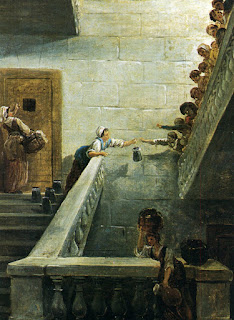
During his imprisonment at saint-Lazare during the Terror, Robert completed over fifty drawings and paintings, including pictures on earthernware plates, many of which he sold. As well as imagined scenes antiquity, he produced sketches of the prison world around him.
Robert was arrested as a "suspect" on 8 brumaire Year II (29th October 1793). The denunciation, from the section des Tuileries, still exists. The immediate pretext was that he had failed to renew his citizen's card. Élisabeth Vigée Le Brun accused David himself of the denunciation.
With his ties to the French aristocracy, Robert was bound to be regarded with suspicion. Even at the height of the Revolution he still maintained contact with former clients and patrons in the high nobility and financial aristocracy, and rooms that he had decorated werediscovered in many of the urban palaces and country houses confiscated during the Revolution.
Robert was held initially at the former convent of sainte-Pélagie and transferred on the night of January 30-31 1794 to saint-Lazare. Among his companions at sainte-Pélagie were a whole collection of liberal figures - the antiquarian Aubin-Louis Millin de Grandmaison, Joseph Audran, from the Gobelins, the painter Restout, the former Constituent Chabroud, General Biron and the Admiral d'Estaing. Above all he shared his captivity with his longtime friend the poet Antoine Roucher. Fear as to their utimate fate must have preoccupied the prisoners, but the company determined to endure with bravado. Robert is stated to have behaved with unfailing good humour. In a margin of one of Roucher's letters he sketched female heads representing Patience and Hope.
At Sainte-Pelagie detainees with money could secure a certain degree of comfort. They could have a private cell shared with one or two companions. Roucher's cost him 15 livres a month. They could send for food from outside and were also allowed a certain amount of contact with their relatives. The letters of Roucher to his daughter often mention Robert. Roucher asks his daughter for a copy of de Savary's Travels in Egypt so that Robert, if he could not paint, could at least indulge his love antiquity and forget for a moment "the locks and bars of sainte-Pélagie." Later Robert, who had by then acquired rudimentary materials, discovered details of the life of St. Pelagie and set about painting her among the ruins of ancient Asia.
 |
Plate depicting the prison of saint-Lazare
National Museum of Western Art, Tokoyo |
 |
| Gaoler inscribing the names of prisoners entering the prison saint-Lazare Painting on a plate from the Musée Lambinet |
Unlike Roucher and his companion André Chenier, who were implicated in the so-called "prison plots", Robert was safely released after Thermidor, on 5th August 1794. According to one story - which may originate with Robert himself - he was saved from the guillotine only by his common surname; his name was read out among the condemned but another prisoner called Robert identified himself and was taken in his stead.
Portraits of the artist in his cell at Saint-Lazare
 |
Self-portrait at sainte-Pélagie (?),
Musée Carnavalet
|
 |
| The artist in his cell at saint-Lazare. Drawing finished in pen and black ink,plus coloured washes. 26 x 33 cm. Private collection of Dian Woodner and Andrea Woodner, NY. Eighteenth-century French Drawings in New York Collections.Metropolitan Museum of Art (1999) No.96.,p.222-3. https://books.google.co.uk/books?id=1pnGSWQcjfgC&dq=&pg=RA1-PA222 |
 |
| Hubert Robert in his cell at St.Lazare Sold by Sotherby's ,New York, Thursday, January 24, 2002 http://www.artvalue.com/auctionresult--robert-hubert-1733-1808-france-hubert-robert-in-his-cell-in-t-1764653.htm |
Scenes of prison life
These three paintings are from the collections of the musée Carnavalet. The first depicts the "corridor Germinal". Robert is clearly visible in the centre in his long coat. The small boy is Roucher's son Emile. The third canvas was commissioned by the Duc d'Audiffret-Pasquier, Robert's prison mate, as a souvenir with which to remember the kind milk sellers who offered a small reprieve to the prisoners during their imprisonment. A slightly smaller version was auctioned by Sotherby's in 2002.
http://www.sothebys.com/en/auctions/ecatalogue/2014/old-master-paintings-n09161/lot.89.html
 |
| Corridor of the saint-Lazare Prison in 1793 |
 |
| Game of ball in the Courtyard at saint-Lazare |
 |
| Bringing milk to the prisoners at saint-Lazare in 1794 |
A Portrait of Antoine Roucher
This picture is identified as Roucher "awaiting transfer from Sainte-Pélagie" though it looks more like another room in Saint-Lazare. The bag perhaps suggests he is packed up as though about to depart. The subject was formerly misidentified as Camille Desmoulins.
See
The Age of Watteau, Chardin, and Fragonard: Masterpieces of French Genre Painting Yale UP (2003)
https://books.google.co.uk/books?id=1NF55AAR0bcC&pg=PA314&lpg=PA314
A portrait of Louis XVII?
 |
| Game of cards at Sainte-Pélagie (Musée des beaux arts d’'Orléans) Drawing finished in pen and black ink,plus coloured washes 26cm x 40 cm Signed on the bottom left” "Robert fecit in Sta Pelagiae aedibus" http://www.photo.rmn.fr/archive/05-531863-2C6NU0BHKJ9T.html |
Royalists would dearly love this picture to represent the dauphin Louis XVII who may have briefly visited sainte-Pélagie with his warder Simon in 1793. A 19th-century catalogue identifies the subject as "Louis XVII at the Temple". More likely the little boy is Roucher's five-year old son Emile who was allowed to keep his father company in prison. Commentators point out that the adult does not resemble Roucher - but he does seem to be wearing the poet's Rousseau-inspired fur-hat.
See
CRIL17: A la recherche de la vérité sur Louis XVII
Iconographie, no. 17: http://cril17.org/2012/12/14/iconographie-17/
Iconographie, no. 24: http://cril17.org/2012/12/18/iconographie-24/
The Sleep of Marat
 |
| The sleep of Marat http://sammlungenonline.albertina.at/?query=Inventarnummer=[12439]&showtype=record |
References
Details of Robert's imprisonment are from:
C. Gabillot, Hubert Robert et son temps, Paris 1895
https://archive.org/stream/hubertrobertetso00gabi#page/182/mode/2up



No comments:
Post a Comment